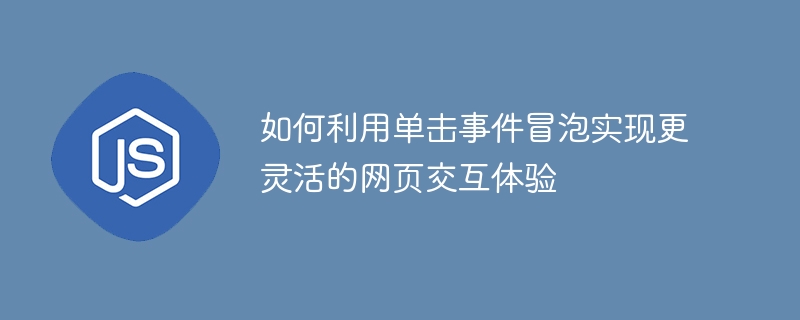Home >Web Front-end >JS Tutorial >How to enhance web page interaction experience by utilizing click event bubbling
How to enhance web page interaction experience by utilizing click event bubbling
- PHPzOriginal
- 2024-01-13 14:23:061221browse

How to use click event bubbling to achieve a more flexible web page interaction experience
Introduction: In front-end development, we often encounter the need to add some elements to a web page Add a click event. However, if there are many elements in the page, adding click events to each element will become very tedious and inefficient. Click event bubbling can help us solve this problem by adding click events to public parent elements to achieve a more flexible web page interaction experience.
1. The principle of click event bubbling
Click event bubbling means that when a click event on an element is triggered, the event will be passed to the parent element of the element, and then passed The parent element of the parent element, passed up to the document root element until canceled or until the root element is reached.
For example, we have the following HTML structure:
<div id="container">
<div id="box1">
<div id="box2"></div>
</div>
</div>If we add a click event on the box2 element and trigger the event by clicking on the box2 element, then the click event will be passed to box2 and box1 in sequence and container elements.
2. Use event bubbling to achieve more flexible interaction
Using click event bubbling, we can add click events to the public parent element to achieve a more flexible interaction effect. Specifically, we can follow the following steps to achieve this:
- Get the elements that need to add click events and the common parent elements
First, we need to get the elements that need to add click events and the elements of these elements Common parent element. You can use the document.querySelector() or document.querySelectorAll() method to obtain element nodes, and use event delegation to add click events to the common parent element.
For example, if we want to add click events to all sub-elements under the container element, we can use the following code:
const container = document.querySelector('#container');
const children = container.children;
container.addEventListener('click', function(event) {
// 点击事件处理逻辑
});- Judge the source element of the event
In the click event processing logic , we can determine the source element of the click event through the event.target attribute. The event.target attribute points to the specific element that triggered the event.
For example, if we want to determine whether the click event comes from the box1 or box2 element, we can use the following code:
container.addEventListener('click', function(event) {
if (event.target.id === 'box1' || event.target.id === 'box2') {
// 处理逻辑
}
});- Perform different operations based on different source elements
According to what we For the required operations, we can add the corresponding code in the processing logic of the click event. Perform different operations based on different source elements.
For example, if we want to pop up a prompt box when the box1 element is clicked and change its background color when the box2 element is clicked, we can use the following code:
container.addEventListener('click', function(event) {
if (event.target.id === 'box1') {
alert('你点击了box1');
} else if (event.target.id === 'box2') {
event.target.style.backgroundColor = 'red';
}
});Through the above code, we have achieved Perform different operations when clicking on the box1 or box2 element.
Summary: Using click event bubbling, we can achieve a more flexible web page interaction experience in front-end development. By adding click events to common parent elements, you can reduce the number of event bindings and improve the maintainability and scalability of your code. At the same time, by judging the source element of the event, we can also perform different operations on different elements. I hope this article can help readers better understand click event bubbling and apply it effectively in actual development.
The above is the detailed content of How to enhance web page interaction experience by utilizing click event bubbling. For more information, please follow other related articles on the PHP Chinese website!

